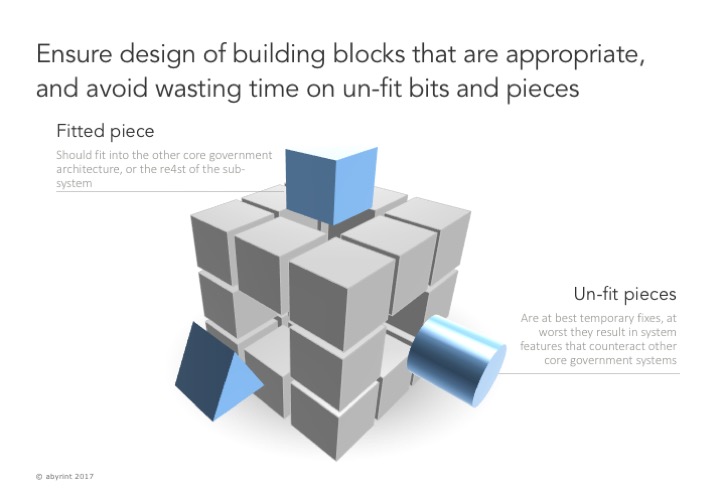Sovereign Reconstruction: A Modular Approach to State Building
Published on: Mon Dec 11 2017 by Ivar Strand
What is a building block of a core government system?
This could be a manual, a law, a work-flow, a job description, and organization, or a digital system that are designed to support the government in its work.
Ideally, these systems would be closely thought through, being logically consistent, and providing for an efficient system. This is not the case.
And more importantly, when rebuilding the state, much effort is directed towards developing bits and pieces of the state, and unfortunately, providing solutions that are un-fit. They don’t fit the situation, don’t address the problem, and don’t fit into other sub-systems of government. Wasting resources and time, creating a short-term perception of improvement, but ultimately failing to deliver better performance and drawing away resources from what really matters.
At Abyrint, we have supported fragile states governments in rebuilding their core government functions for some years. We have come to realize how big of a problem this really is.
We discuss one particular commonly occurring phenomena of non-fittable solutions: the bits and pieces approach
Bits and pieces approach
This is the situation where several deliverables, over time, and often supported by different externally donor funded investments, produces bits-and-pieces, all meant to support a bigger objective, but are logically inconsistent designs. Other approaches to change management and capacity building include experiments, pilots and temporary solutions.
Exhibit 1: Building blocks of the state

The rationale, in isolation, may make sense, but all the different pieces fit very poorly together. The result is that state capability remains disorganized, with contradictory and ambiguously defined solutions that are not mutually supportive.
Consider for example the common problem of mismatched legal traditions. I.e legal frameworks, sometimes within the same sector, draws upon different legal traditions, and the consequence is fundamental ambiguity about core mandates, roles and responsibilities.
Consider for example the “cottage industry” of producing manuals and guidelines that prescribe solutions for work flows, roles and responsibilities and information flows. These are often delivered, as basically copies of manuals from somewhere else, with complete disregard for the specific situation and the fittability of the systems in this particular country with its other sub-systems.
It requires a very high capacitated government to identify such fallacies real-time.
Some damage can be avoided by not implementing such solutions, which at best results in deliverables being shelved. Obviously with a waste of time and resources and consequence.
The worse outcome is when such solutions are actually implemented, resulting in unfit designs from the outset, and leading to bigger investments down the line to repair the damage.
How to create building blocks that are fit for purpose
The solution is to turn the bits and pieces approach into a building block approach. Think Tetris. Think puzzles. The pieces should fit together and integrate into the bigger systems that are a part of long term solution.
Fragile states governments would ideally have the capability to recognize the core systems features needed, and scale and fit solutions across the system. These are scarce skills. This requires a system design capability, that is a scarce and highly valued skill, anywhere in the world.
It is also difficult to manage and coordinate such processes, and especially in an environment where there are many critical external stakeholders. The reality of many fragile states governments that are rebuilding, is that they are dependent upon external financing, also for producing the core building blocks of the new government systems.
International and bilateral agencies, are all supporting government with the best of intentions, but at high risk of providing bits and pieces that fit poorly together.
A good starting point is probably a healthy degree of skepticism:
- Assume that the solutions on the table are mismatched bits and pieces
- Challenge the design assumptions
- Challenge those that offer canned solutions, but have a limited understanding of the specific problems
- Question how this fits together with other sub-systems
- Ultimately, only accept solutions where fittability is demonstrated
And ideally, attempt from an early stage, to build core capacity at the center, i.e Ministry of Finance, or Prime Ministers Office, or in other critical agencies, that can identify important design features real-time, and that can influence choices of solutions.
At Abyrint we support fragile states governments in capacity building. We focus on institution building. Rebuilding the critical institutions that will enable the countries to grow and develop.
By Ivar Strand @abyrint



